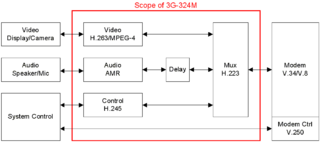Related Research Articles
3GP is a multimedia container format defined by the Third Generation Partnership Project (3GPP) for 3G UMTS multimedia services. It is used on 3G mobile phones but can also be played on some 2G and 4G phones.
The IP Multimedia Subsystem or IP Multimedia Core Network Subsystem (IMS) is a standardised architectural framework for delivering IP multimedia services. Historically, mobile phones have provided voice call services over a circuit-switched-style network, rather than strictly over an IP packet-switched network. Various voice over IP technologies are available on smartphones; IMS provides a standard protocol across vendors.
A session border controller (SBC) is a network element deployed to protect SIP based voice over Internet Protocol (VoIP) networks.
The next-generation network (NGN) is a body of key architectural changes in telecommunication core and access networks. The general idea behind the NGN is that one network transports all information and services by encapsulating these into IP packets, similar to those used on the Internet. NGNs are commonly built around the Internet Protocol, and therefore the term all IP is also sometimes used to describe the transformation of formerly telephone-centric networks toward NGN.
Multimedia Broadcast Multicast Services (MBMS) is a point-to-multipoint interface specification for existing 3GPP cellular networks, which is designed to provide efficient delivery of broadcast and multicast services, both within a cell as well as within the core network. For broadcast transmission across multiple cells, it defines transmission via single-frequency network configurations. The specification is referred to as Evolved Multimedia Broadcast Multicast Services (eMBMS) when transmissions are delivered through an LTE network. eMBMS is also known as LTE Broadcast.

Wi-Fi calling, also called VoWiFi, refers to mobile phone voice calls and data that are made over IP networks using Wi-Fi, instead of the cell towers provided by cellular networks. Using this feature, compatible handsets are able to route regular cellular calls through a wireless LAN (Wi-Fi) network with broadband Internet, while seamlessly change connections between the two where necessary. This feature makes use of the Generic Access Network (GAN) protocol, also known as Unlicensed Mobile Access (UMA).

3G-324M is the 3GPP umbrella protocol for video telephony in 3G mobile networks.
Mobile VoIP or simply mVoIP is an extension of mobility to a voice over IP network. Two types of communication are generally supported: cordless telephones using DECT or PCS protocols for short range or campus communications where all base stations are linked into the same LAN, and wider area communications using 3G or 4G protocols.
Text over IP is a means of providing a real-time text (RTT) service that operates over IP-based networks. It complements Voice over IP (VoIP) and Video over IP.
The 3GPP has defined the Voice Call Continuity (VCC) specifications in order to describe how a voice call can be persisted, as a mobile phone moves between circuit switched and packet switched radio domains.
The Global mobile Suppliers Association (GSA) is a not-for-profit industry organisation representing suppliers in the mobile communication industry. GSA actively promotes 3GPP technology such as 3G; 4G; 5G. GSA is a market representation partner in 3GPP and co-operates with organisations including COAI, ETSI, GSMA, ICU, ITU, European Conference of Postal and Telecommunications Administrations (CEPT-ECC), other regional regulatory bodies and other industry associations.

Video Share is an IP Multimedia System (IMS) enabled service for mobile networks that allows users engaged in a circuit switch voice call to add a unidirectional video streaming session over the packet network during the voice call. Any of the parties on the voice call can initiate a video streaming session. There can be multiple video streaming sessions during a voice call, and each of these streaming sessions can be initiated by any of the parties on the voice call. The video source can either be the camera on the phone or a pre-recorded video clip.

Image Share is a service for sharing images between users during a mobile phone call. It has been specified for use in a 3GPP-compliant cellular network by the GSM Association in the PRD IR.79 Image Share Interoperability Specification.

IP exchange or (IPX) is a telecommunications interconnection model for the exchange of IP based traffic between customers of separate mobile and fixed operators as well as other types of service provider, via IP based Network-to-Network Interface. IPX is developed by the GSM Association.
The 3GPP/NGN IP Multimedia Subsystem (IMS) multimedia telephony service (MMTel) is a global standard based on the IMS, offering converged, fixed and mobile real-time multimedia communication using the media capabilities such as voice, real-time video, text, file transfer and sharing of pictures, audio and video clips. With MMTel, users have the capability to add and drop media during a session. You can start with chat, add voice, add another caller, add video, share media and transfer files, and drop any of these without losing or having to end the session. MMTel is one of the registered ICSI feature tags.
Wideband audio, also known as wideband voice or HD voice, is high definition voice quality for telephony audio, contrasted with standard digital telephony "toll quality". It extends the frequency range of audio signals transmitted over telephone lines, resulting in higher quality speech. The range of the human voice extends from 100 Hz to 17 kHz but traditional, voiceband or narrowband telephone calls limit audio frequencies to the range of 300 Hz to 3.4 kHz. Wideband audio relaxes the bandwidth limitation and transmits in the audio frequency range of 50 Hz to 7 kHz. In addition, some wideband codecs may use a higher audio bit depth of 16 bits to encode samples, also resulting in much better voice quality.
In telecommunications, long-term evolution (LTE) is a standard for wireless broadband communication for mobile devices and data terminals, based on the GSM/EDGE and UMTS/HSPA standards. It improves on those standards' capacity and speed by using a different radio interface and core network improvements. LTE is the upgrade path for carriers with both GSM/UMTS networks and CDMA2000 networks. Because LTE frequencies and bands differ from country to country, only multi-band phones can use LTE in all countries where it is supported.

Voice over Long-Term Evolution is an LTE high-speed wireless communication standard for voice calls and SMS using mobile phones and data terminals. VoLTE has up to three times more voice and data capacity than older 3G UMTS and up to six times more than 2G GSM. It uses less bandwidth because VoLTE's packet headers are smaller than those of unoptimized VoIP/LTE. VoLTE calls are usually charged at the same rate as other calls.
Narrowband Internet of things (NB-IoT) is a low-power wide-area network (LPWAN) radio technology standard developed by 3GPP for cellular network devices and services. The specification was frozen in 3GPP Release 13, in June 2016. Other 3GPP IoT technologies include eMTC and EC-GSM-IoT.
Enhanced Voice Services (EVS) is a superwideband speech audio coding standard that was developed for VoLTE and VoNR. It offers up to 20 kHz audio bandwidth and has high robustness to delay jitter and packet losses due to its channel aware coding and improved packet loss concealment. It has been developed in 3GPP and is described in 3GPP TS 26.441. The application areas of EVS consist of improved telephony and teleconferencing, audiovisual conferencing services, and streaming audio. Source code of both decoder and encoder in ANSI C is available as 3GPP TS 26.442 and is being updated regularly. Samsung uses the term HD+ when doing a call using EVS.
References
- ↑ "GSMA IR.94" (PDF).
- ↑ Lennart Norell (3 May 2013) IR.94 IMS Profile for Conversational Video Service (PDF) GSMA. Retrieved 5 January 2015
- ↑ "3GPP TS 26.114 - IP Multimedia Subsystem (IMS); Multimedia telephony; Media handling and interaction" . Retrieved 2 February 2015.
- ↑ "3GPP TS 23.203 Policy and Charging Control Architecture" . Retrieved 2 February 2015.
- ↑ GSA: VoLTE and ViLTE: Global Market Update (February 2019)
- ↑ GSA: VoLTE & ViLTE: Global Market Update, August 2019
- ↑ GSA: VoLTE & ViLTE: Global Market Update, August 2019